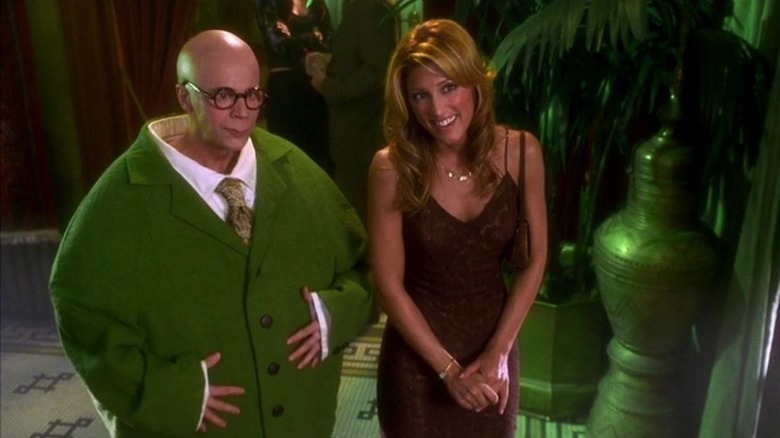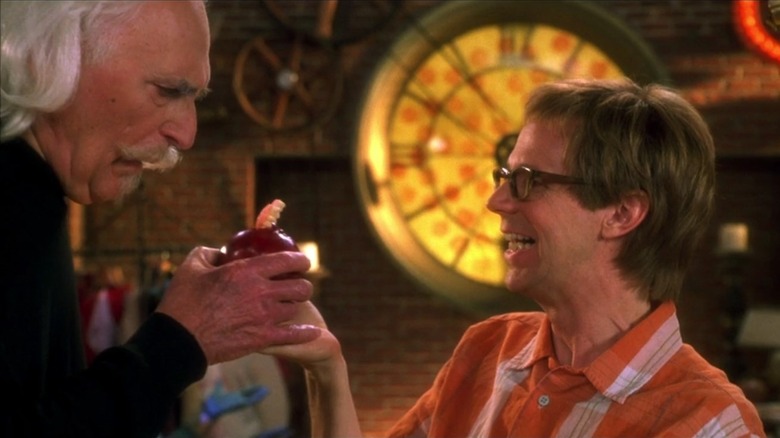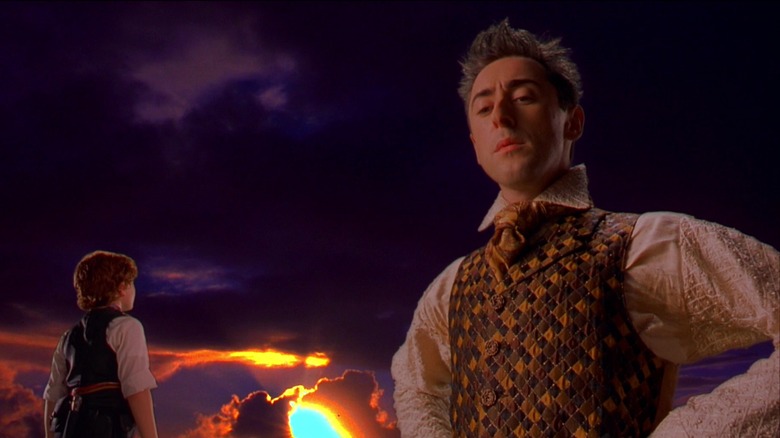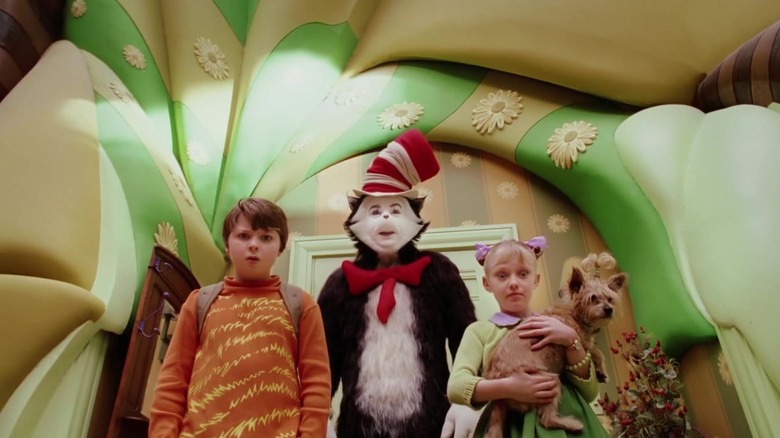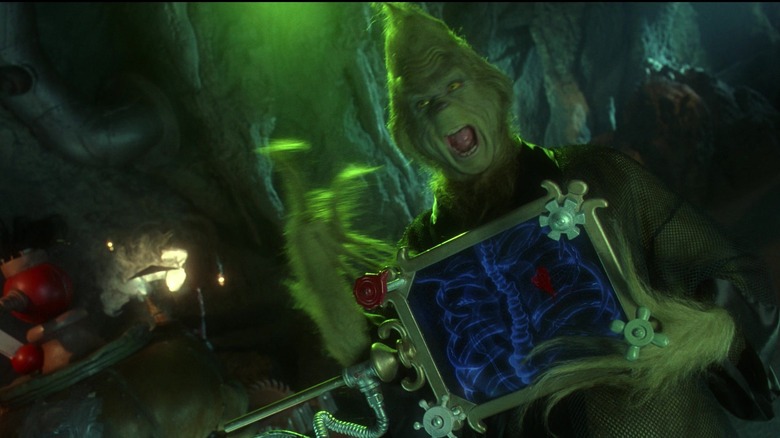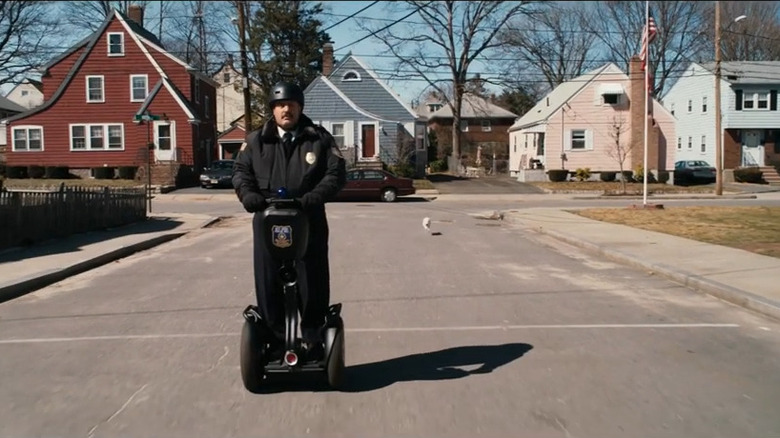How Master Of Disguise Represents A Rightfully Forgotten Era Of Hollywood History
"Master of Disguise" is remembered today for two reasons. The first is a scene in which its star, Dana Carvey, infiltrates an exclusive club known as the Turtle Club by dressing in a large green turtle-like suit. Led by the arm of a pained-looking Jennifer Esposito, Carvey bobs his head and makes noises that sound like a death rattle. He threatens bystanders, retreats into his suit when provoked, and (in the most terrifying scene of all) bites a man's nose off only to spit it right back onto his face. The scene ends with him spinning on his back on the ground, rattling madly. It is a pure manifestation of wrongness on par with the diner scene in "Mulholland Drive."
The second is the pervasive rumor spread via the Internet Movie Database that the Turtle Club scene was filmed on September 11, 2001, leading to a moment of silence on set. An article on Defector corrected the record, alleging that "Master of Disguise" was still in pre-production when the Twin Towers fell. Dana Carvey did in fact observe a moment of silence while wearing the turtle suit, but two weeks after September 11 on the first day of filming. Director Perry Andelin Blake offered a pep talk to his staff beforehand, reminding them that "there's something good about us coming together to make a movie that would make kids laugh." Shorn of this bit of trivia, "Master of Disguise" may be appreciated for what it is: a bad movie.
Salvaged junk
The badness of "Master of Disguise" is multi-layered. It is not simply that it is racist, sexist, and transphobic, although it is. These lazy choices were common in 2002, even for movies people liked. What distinguishes "Master of Disguise" is sloppiness. The ending credits, a collection of deleted scenes and weird gags that go on for nearly 10 minutes, are a full eighth of the movie's runtime. The film's pop culture gags riff on movies like "The Exorcist" and "Jaws" that the target audience of "Master of Disguise" likely haven't seen yet. Not to mention the transition between the second and third act is whiplash-inducing. "Master of Disguise" is less a functional comedy than it is a teetering pile of salvaged junk that its producers badly want to pretend is a movie.
Dana Carvey, the star of "Master of Disguise," is a talented comedian whose doomed "Dana Carvey Show" hired Steve Carrell and Stephen Colbert years before they blew up. "Master of Disguise" presented a chance to leverage his skill at impressions into a film career following the heights of "Wayne's World." But as film critic Matt Singer noted in ScreenCrush, "Carvey is a master of impressions, not a master of disguise, and those are not the same thing." Every Carvey skit in the film boils down to Carvey, playing hapless secret agent Pistachio Disguisey, mugging at the camera while the remaining cast stare at him, confused. Outside of deranged horror sequences like the Turtle Club, Carvey just can't carry the movie alone, and there isn't much anyone can do to help him within the film's repetitive structure. Even his cute dog is helpless in the face of the cinematic black hole that is "Master of Disguise."
A new world of cinema
"Master of Disguise" was not just a bad movie, but a bad movie of its era. The late '90s and 2000s saw Hollywood in the midst of a technical revolution. George Lucas' "Star Wars" prequels gave rise to an entirely new method of making movies, even if the films themselves were uneven. "Babe" made animals talk, and "Baby Geniuses" (unfortunately) made babies talk. Filmmakers once limited by production realities found those limits expanding every day. One such filmmaker was Robert Rodriguez, whose "Spy Kids" combined practical and digital effects to charming effect in 2001. By "Spy Kids 3-D: Game Over," released in 2003, Rodriguez and his team had fully embraced digital effects, but sacrificed the tangibility of their worlds in the process. Rodriguez hoped that building sets and creatures in post-production would allow for direct creative control that might not otherwise be possible. Instead his movies were brought screaming into the uncanny valley.
"Spy Kids" was just one of many special effects driven children's comedies being made in Hollywood. Far more influential was 2000's "How the Grinch Stole Christmas," directed by Ron Howard of "Apollo 13." Dr. Seuss's original story had already been adapted into a classic Christmas special. But this new production sought to do something even more ambitious, which was to fully realize the world of Dr. Seuss in live-action. Comedy superstar Jim Carrey was transformed into the titular character via layers and layers of makeup. The film went on to achieve astonishing box office numbers. But something had gone wrong. The whimsy of Seuss (and the distinct charms of its animated adaptation) curdled under the lights of a live action film set. As successive films sought to capture the success of "Grinch," their production design mutated to further grotesque extremes.
Cursed objects
The director of "Master of Disguise," Perry Andelin Blake, is by trade a production designer. Blake is also a trained architect who graduated from Harvard to work with the famed Frank Gehry in Los Angeles. By the hands of his crew, Pistachio Disguisey's secret headquarters is crammed with puppets, mechanical moving bookshelves and steampunk bric-a-brac. My personal favorite prop in the film is called the Disguisey Ball of Knowledge, which looks like a variant of the puzzle box from "Hellraiser" sold at a Cheesecake Factory. "Master of Disguise" wasn't even the only children's film to riff on "Hellraiser" that year. The live action "Scooby-Doo" film, which premiered two months before, featured a freaky transforming pyramid called the Daemon Ritus. I'm not sure exactly why so many of these films featured chintzy yet sinister artifacts, but it exerts a strong pull of nostalgia on me regardless. Perhaps a young James Gunn, credited for early drafts of the "Scooby-Doo" script, is responsible.
Speaking of chintzy yet sinister artifacts, Mike Myers' famously evil "Cat in the Hat" film was released just one year later in 2003. This film was directed by Bo Welch, another production designer. Welch had brought the worlds of "Beetlejuice" and "Men in Black" to convincing life. Unfortunately, he was no more successful in evoking the world of "Seuss" than "Grinch." The film's efforts to conjure a whimsical land of make-believe are killed stone dead by the line delivery of its star Mike Myers. The corpse left behind festers into something rather ugly, simultaneously insincere and overwrought. It's no coincidence that the film has become a popular source for parody horror trailers.
The end of the road
There's something particularly illusory about these movies, as if they were fake posters in a half-remembered film. It's hard to believe, for instance, that there is a scene in "The Cat in the Hat" where Mike Myers's hat pops a boner. Or that the quote "Do you think God stays in heaven because he too lives in fear of what he has created?" comes from "Spy Kids 2." We haven't even mentioned "Superbabies: Baby Geniuses 2," whose villain modeled his performance on the Nazi mass murderer Josef Mengele. But once upon a time, popular comedians, hard-working special effects crews, and producers convinced they had the next big thing signed off on all of these films. Some began as doomed passion projects, others were phoned in. Most were forgotten. Yet to this day my friends and coworkers can still quote Carvey saying "turtle, turtle."
At some point in the past few years, the special effects-driven children's comedy went extinct. There are exceptions, such as Raja Gosnell's endless talking animal movies. But the true successors of "Master of Disguise" are found in the films of animation studios like Illumination and DreamWorks. The past decade saw Will Ferrell and company usurp the levels of power from the Myers and Carveys of the world, only to be usurped in turn by the relative realism of Judd Apatow and Paul Feig. Now Apatow and Feig themselves are out of fashion, and comedy has undergone so many dizzying transformations that the film industry can barely keep up. If Pistachio Disguisey watched "Everything Everywhere All at Once" or the television series "The Rehearsal," he would turn into a pillar of salt.
Pistachio Disgusey lives
Part of me misses films like "Master of Disguise" and "The Cat in the Hat." Many of them were terrible, offensive, and poorly made, haunted by production failure and corporate interference. But at least they were obvious disasters, wearing their dysfunction on the outside. Today's blockbusters exhibit a disquieting safeness that makes me wish for those earlier, loopier times. The recent live-action remake of "Pinocchio" is, at first glance, a perfectly functional movie that reinterprets a children's classic in live action. It's only when you pay attention that you realize the film is a commercially and spiritually craven regurgitation of superior material that wastes its cast and crew so that Disney might satisfy its shareholders and keep a hold on the copyright. "Master of Disguise" is no more cynical than "Pinocchio," and is perhaps more flavorful even if that flavor is disgusting.
Meanwhile, the true legacy of "Master of Disguise" continues in Adam Sandler's studio Happy Madison Productions. Having assisted Carvey in bringing his idea to life, Happy Madison now produces films like "Paul Blart: Mall Cop," "Pixels" and "Murder Mystery." They even employ Perry Andelin Blake, who maintains a prolific career as a production designer even though he has yet to direct another movie since "Master of Disguise." Carvey himself would appear in "Jack and Jill" as well as Sandler's own "Hotel Transylvania 2." With a Netflix deal in the can, Sandler and his friends are poised to torture audiences for years to come. We should be so lucky.
